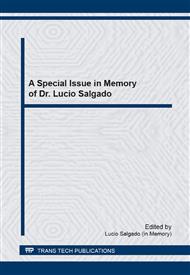p.585
p.591
p.598
p.604
p.609
p.615
p.621
p.627
p.632
Influence of Two-Step Sintering on Ceramic Nanocomposites Microstructure
Abstract:
Two-step sintering has been able to produce fully dense bodies and with controlled grain size, without pressure during sintering. In this study, it was studied the sintering behavior of alumina-5% vol zirconia powders submitted to high energy milling. For this, the mixture of 5% vol of Y2O3 partially stabilized zirconia and 95% vol alumina powder was performed by high-energy ball milling (Spex 8000) with a ball ratio: mass of material at 7:1, in a steel vial with balls of steel, in milling times from 0 to 7 hours. The milled powders were characterized by X-ray fluorescence (XRF) and X-ray diffraction (XRD). After milling, the powders were uniaxially pressed and two-step sintered with heating at a temperature of 1500 oC for 5 minutes, cooling until 1450°C and then sintering at this temperature for 2 hours. The sintered composites were analyzed by X-ray diffraction, apparent density and scanning electron microscopy. The results were compared with the conventional sintering and showed that the microstructure of the nanocomposites appears more refined and homogeneous when they are sintered in steps.
Info:
Periodical:
Pages:
609-614
Citation:
Online since:
September 2014
Keywords:
Price:
Сopyright:
© 2015 Trans Tech Publications Ltd. All Rights Reserved
Share:
Citation:


